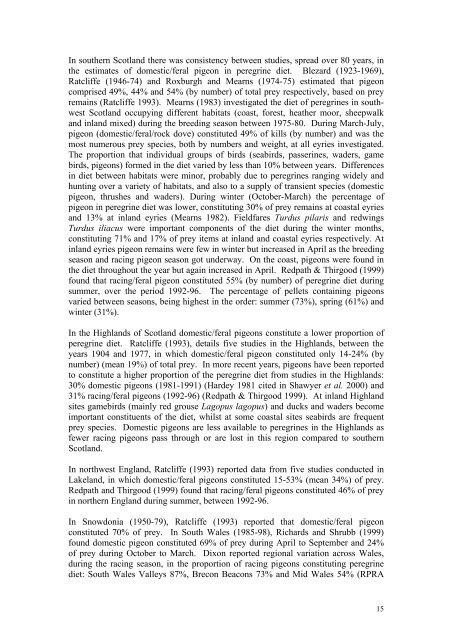RACING PIGEONS â IMPACT OF RAPTOR PREDATION
RACING PIGEONS â IMPACT OF RAPTOR PREDATION
RACING PIGEONS â IMPACT OF RAPTOR PREDATION
Create successful ePaper yourself
Turn your PDF publications into a flip-book with our unique Google optimized e-Paper software.
In southern Scotland there was consistency between studies, spread over 80 years, in<br />
the estimates of domestic/feral pigeon in peregrine diet. Blezard (1923-1969),<br />
Ratcliffe (1946-74) and Roxburgh and Mearns (1974-75) estimated that pigeon<br />
comprised 49%, 44% and 54% (by number) of total prey respectively, based on prey<br />
remains (Ratcliffe 1993). Mearns (1983) investigated the diet of peregrines in southwest<br />
Scotland occupying different habitats (coast, forest, heather moor, sheepwalk<br />
and inland mixed) during the breeding season between 1975-80. During March-July,<br />
pigeon (domestic/feral/rock dove) constituted 49% of kills (by number) and was the<br />
most numerous prey species, both by numbers and weight, at all eyries investigated.<br />
The proportion that individual groups of birds (seabirds, passerines, waders, game<br />
birds, pigeons) formed in the diet varied by less than 10% between years. Differences<br />
in diet between habitats were minor, probably due to peregrines ranging widely and<br />
hunting over a variety of habitats, and also to a supply of transient species (domestic<br />
pigeon, thrushes and waders). During winter (October-March) the percentage of<br />
pigeon in peregrine diet was lower, constituting 30% of prey remains at coastal eyries<br />
and 13% at inland eyries (Mearns 1982). Fieldfares Turdus pilaris and redwings<br />
Turdus iliacus were important components of the diet during the winter months,<br />
constituting 71% and 17% of prey items at inland and coastal eyries respectively. At<br />
inland eyries pigeon remains were few in winter but increased in April as the breeding<br />
season and racing pigeon season got underway. On the coast, pigeons were found in<br />
the diet throughout the year but again increased in April. Redpath & Thirgood (1999)<br />
found that racing/feral pigeon constituted 55% (by number) of peregrine diet during<br />
summer, over the period 1992-96. The percentage of pellets containing pigeons<br />
varied between seasons, being highest in the order: summer (73%), spring (61%) and<br />
winter (31%).<br />
In the Highlands of Scotland domestic/feral pigeons constitute a lower proportion of<br />
peregrine diet. Ratcliffe (1993), details five studies in the Highlands, between the<br />
years 1904 and 1977, in which domestic/feral pigeon constituted only 14-24% (by<br />
number) (mean 19%) of total prey. In more recent years, pigeons have been reported<br />
to constitute a higher proportion of the peregrine diet from studies in the Highlands:<br />
30% domestic pigeons (1981-1991) (Hardey 1981 cited in Shawyer et al. 2000) and<br />
31% racing/feral pigeons (1992-96) (Redpath & Thirgood 1999). At inland Highland<br />
sites gamebirds (mainly red grouse Lagopus lagopus) and ducks and waders become<br />
important constituents of the diet, whilst at some coastal sites seabirds are frequent<br />
prey species. Domestic pigeons are less available to peregrines in the Highlands as<br />
fewer racing pigeons pass through or are lost in this region compared to southern<br />
Scotland.<br />
In northwest England, Ratcliffe (1993) reported data from five studies conducted in<br />
Lakeland, in which domestic/feral pigeons constituted 15-53% (mean 34%) of prey.<br />
Redpath and Thirgood (1999) found that racing/feral pigeons constituted 46% of prey<br />
in northern England during summer, between 1992-96.<br />
In Snowdonia (1950-79), Ratcliffe (1993) reported that domestic/feral pigeon<br />
constituted 70% of prey. In South Wales (1985-98), Richards and Shrubb (1999)<br />
found domestic pigeon constituted 69% of prey during April to September and 24%<br />
of prey during October to March. Dixon reported regional variation across Wales,<br />
during the racing season, in the proportion of racing pigeons constituting peregrine<br />
diet: South Wales Valleys 87%, Brecon Beacons 73% and Mid Wales 54% (RPRA<br />
15
















